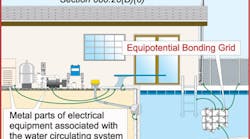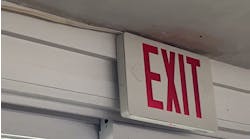The bonding rules for reducing voltage gradients around permanently installed pools, outdoor spas, or outdoor hot tubs were changed again. Here's a summary of the entire section.
(A) Performance. Equipotential bonding is intended to reduce voltage gradients in the area around permanently installed pools, outdoor spas, or outdoor hot tubs by the use of a common bonding grid in accordance with 680.26(B) and (C).
(B) Bonded Parts. The parts of a permanently installed pool, outdoor spa, or outdoor hot tub listed in (B)(1) through (B)(7) shall be bonded together with a solid copper conductor not smaller than 8 AWG with listed pressure connectors, terminal bars, exothermic welding, or other listed means [250.8(A)]. Equipotential bonding is not required to extend to or be attached to any panelboard, service equipment, or grounding electrode.
(1) Conductive Pool, Outdoor Spa, and Outdoor Hot Tub Shells.
(a) Structural Reinforcing Steel. Unencapsulated structural reinforcing steel secured together by steel tie wires is considered bonded.
(2) Perimeter Surfaces. An equipotential bonding grid shall extend 3 ft horizontally beyond the inside walls of a pool, outdoor spa, or outdoor hot tub, including unpaved, paved, and poured concrete surfaces. The bonding grid shall comply with (a) or (b) and be attached to the conductive pool reinforcing steel at a minimum of four points uniformly spaced around the perimeter of the walls of a pool, outdoor spa, or outdoor hot tub.
(a) Structural Reinforcing Steel. Structural reinforcing steel [680.26(B)(1)(a)]. Author’s Comment: The 2008 NEC does not provide any guidance on the installation requirements for structural reinforcing steel when used as a perimeter equipotential bonding grid.
(b) Alternate Means. Equipotential bonding conductor meeting the following:
(1) 8 AWG bare solid copper bonding conductor.
(2) The bonding conductor shall follow the contour of the perimeter surface.
(3) Listed splicing devices.
(4) Bonding conductor shall be 18 to 24 in. from the inside walls of the pool.
(5) Bonding conductor shall be secured within or under the perimeter surface 4 to 6 in. below the subgrade.
(3) Metallic Components. Metallic parts of the pool, outdoor spa, or outdoor hot tub structure shall be bonded to the equipotential grid.
(4) Underwater Metal Forming Shells. Metal forming shells and mounting brackets for luminaires and speakers shall be bonded to the equipotential grid.
(5) Metal Fittings. Metal fittings sized 4 in. and larger that penetrate into the pool, outdoor spa, or outdoor hot tub structure, such as ladders and handrails shall be bonded to the equipotential grid.
(6) Electrical Equipment. Metal parts of electrical equipment associated with the pool, outdoor spa, or outdoor hot tub water circulating system, such as water heaters, pump motors, and metal parts of pool covers shall be bonded to the equipotential grid. (see Figure)
Exception: Metal parts of listed equipment incorporating an approved system of double insulation is not required to be bonded to the equipotential grid.
(a) Double-Insulated Water Pump Motors. Where a double-insulated water-pump motor is installed, a solid 8 AWG copper conductor from the bonding grid shall be provided for a replacement motor.
(b) Pool Water Heaters. Pool water heaters shall be grounded and bonded in accordance with equipment instructions.
(7) Metal Wiring Methods and Equipment. Metal-sheathed cables and raceways, metal piping, and all fixed metal parts shall be bonded to the equipotential grid.
Exception No. 1: Where separated from the pool, outdoor spa, or outdoor hot tub structure by a permanent barrier.
Exception No. 2: Where located more than 5 ft horizontally of the inside walls of the pool, outdoor spa, or outdoor hot tub structure.
Exception No. 3: Where located more than 12 ft measured vertically above the maximum water level.
(C) Pool Water. A minimum conductive surface area of 9 sq in. shall be installed in contact with the pool, outdoor spa, or outdoor hot tub structure water. This water bond is permitted to consist of metal parts that are bonded in 680.26(B). Author's Comment: This section was completely rewritten to clarify equipotential bonding requirements for permanently installed pool, outdoor spa, or outdoor hot tub areas.




